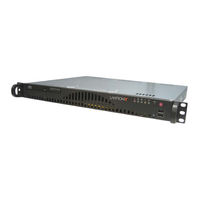Lantronix vSLM Remote Management Software Manuals
Manuals and User Guides for Lantronix vSLM Remote Management Software. We have 1 Lantronix vSLM Remote Management Software manual available for free PDF download: User Manual
Lantronix vSLM User Manual (370 pages)
Secure Lantronix Management; Virtual Secure Lantronix Management
Table of Contents
-
-
Benefits27
-
Firmware29
-
SLM Hardware30
-
-
-
-
-
Syntax44
-
Description44
-
-
Next Steps44
-
-
CLI Commands55
-
-
Syntax55
-
-
-
-
Keep Alive66
-
Ipv4 Filters70
-
-
-
-
-
Copy Keys114
-
Account Groups117
-
Accounts125
-
Viewing Accounts126
-
-
Account Commands132
-
-
-
Ethernet Devices139
-
Listing Devices139
-
-
Device Locator147
-
-
Polling156
-
Device Modem158
-
Traps160
-
Port Access163
-
SLM Proxy170
-
Trap Commands176
-
Ports178
-
Adding a Port180
-
Statistics186
-
Port Commands188
-
-
-
-
-
From a Port198
-
-
-
Guidelines202
-
-
-
-
-
Search for Ports217
-
Search for Users220
-
Using Wildcards222
-
Search Commands222
-
-
Services232
-
Banners234
-
Ssl235
-
Status236
-
Maintenance240
-
Date and Time245
-
SNMP & Syslog247
-
-
SLM Firmware249
-
SLC/SLB Firmware251
-
SLP Firmware253
-
Spider Firmware254
-
Wibox Firmware255
-
-
-
Add Applet262
-
Events265
-
Event Management265
-
-
Files271
-
File Types271
-
File Format273
-
Copying Files277
-
Setting up NFS278
-
Setting up CIFS279
-
-
Logging Commands283
-
-
-
Requirements288
-
Main Menu291
-
Status Menu292
-
Connections293
-
Device Menu294
-
Log Menu298
-
-
-
-
Command Syntax301
-
-
-
Command Help302
-
Tips302
-
Account Commands306
-
CLI Commands316
-
Logging Commands330
-
Audit Log330
-
Event Log332
-
Port Log332
-
Session Log334
-
System Log335
-
Trap Log337
-
-
Managed Devices341
-
Menu Commands346
-
Modem Commands347
-
Network Commands349
-
Port Commands353
-
Search Commands355
-
Session Commands357
-
SSH Key Commands358
-
-
-
-
-
Cover362
-
Power Plug362
-
Input Supply362
-
Grounding362
-
Rack362
-
Port Connections363
-
-
Advertisement
Advertisement
